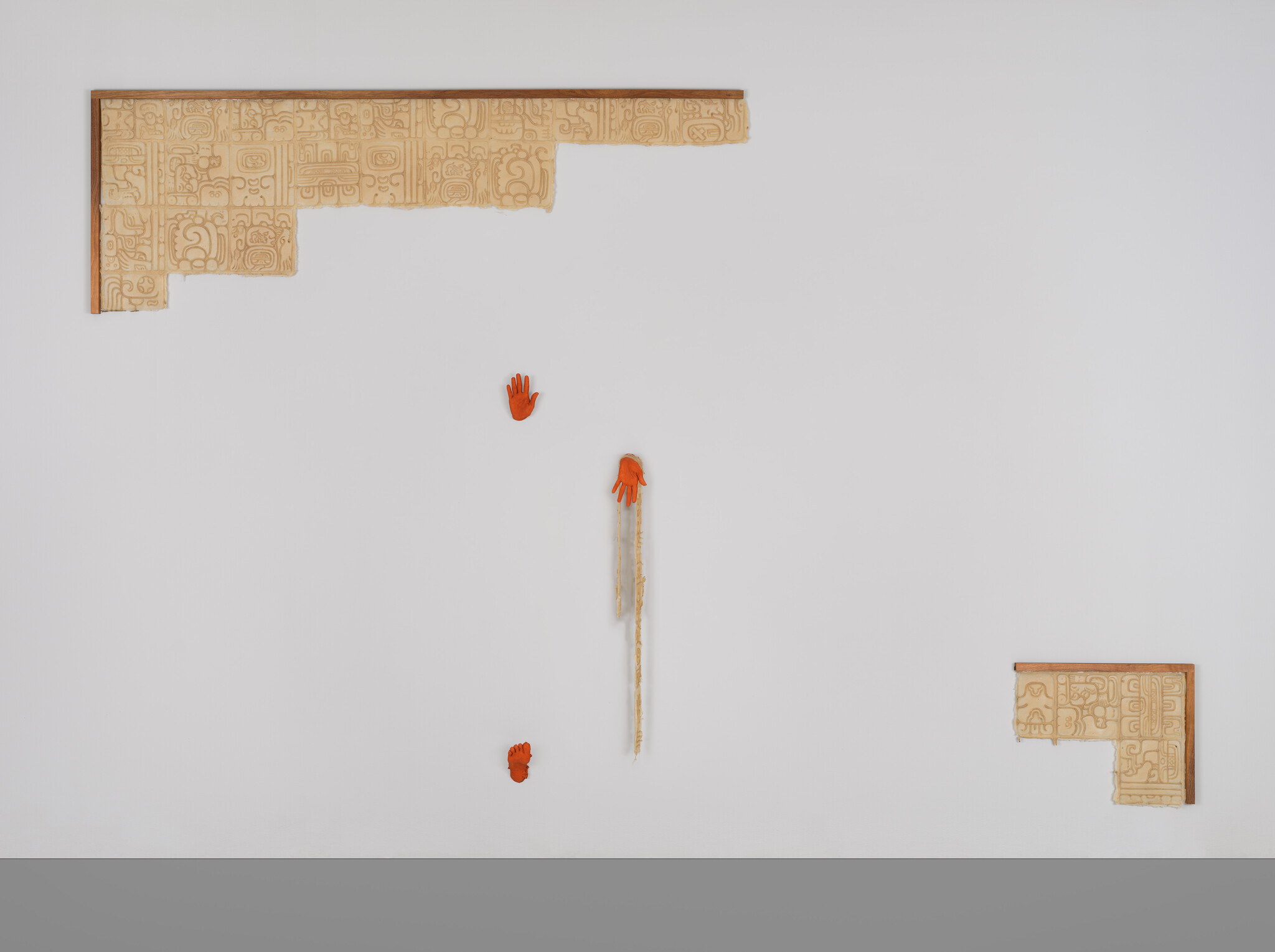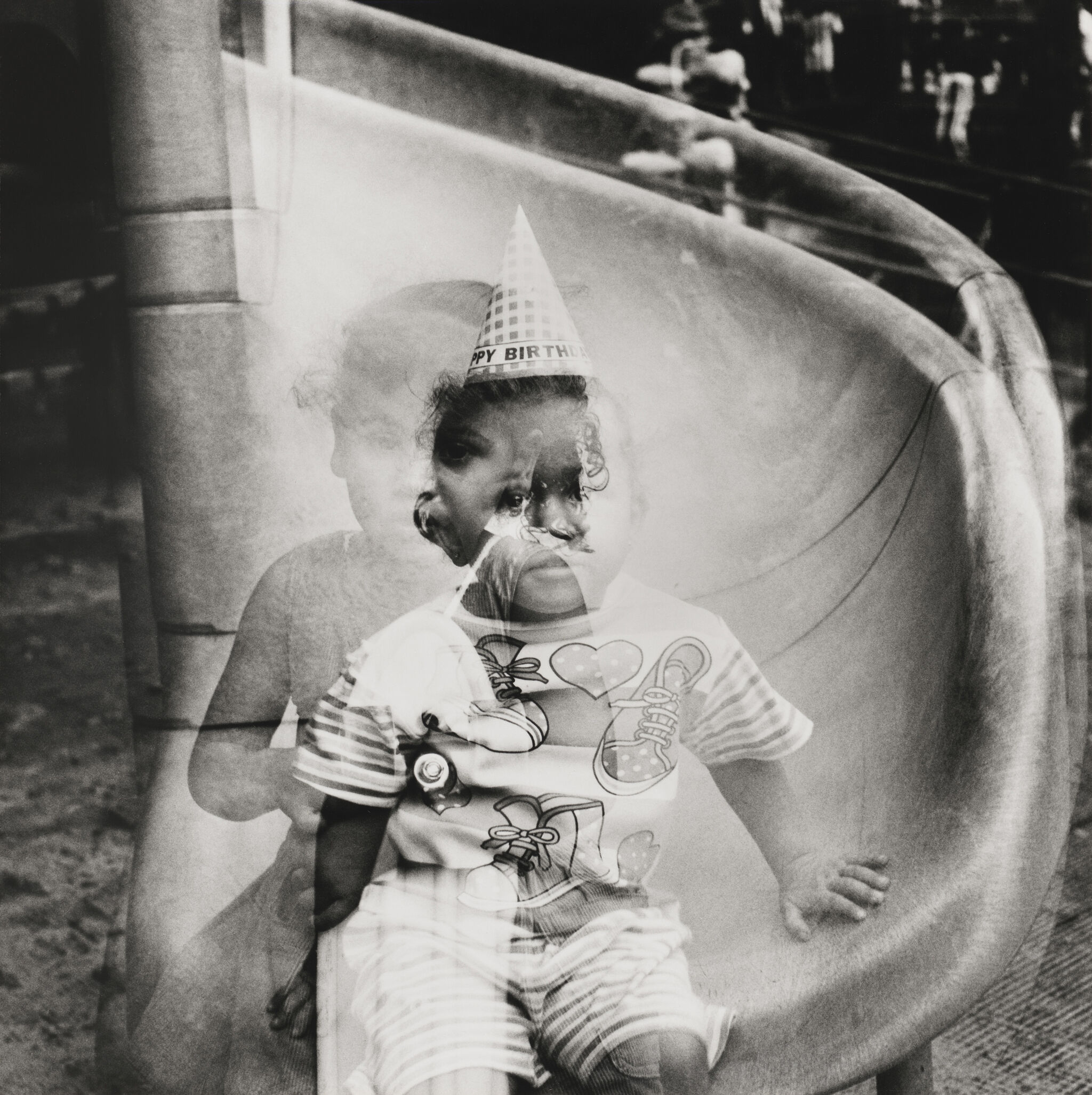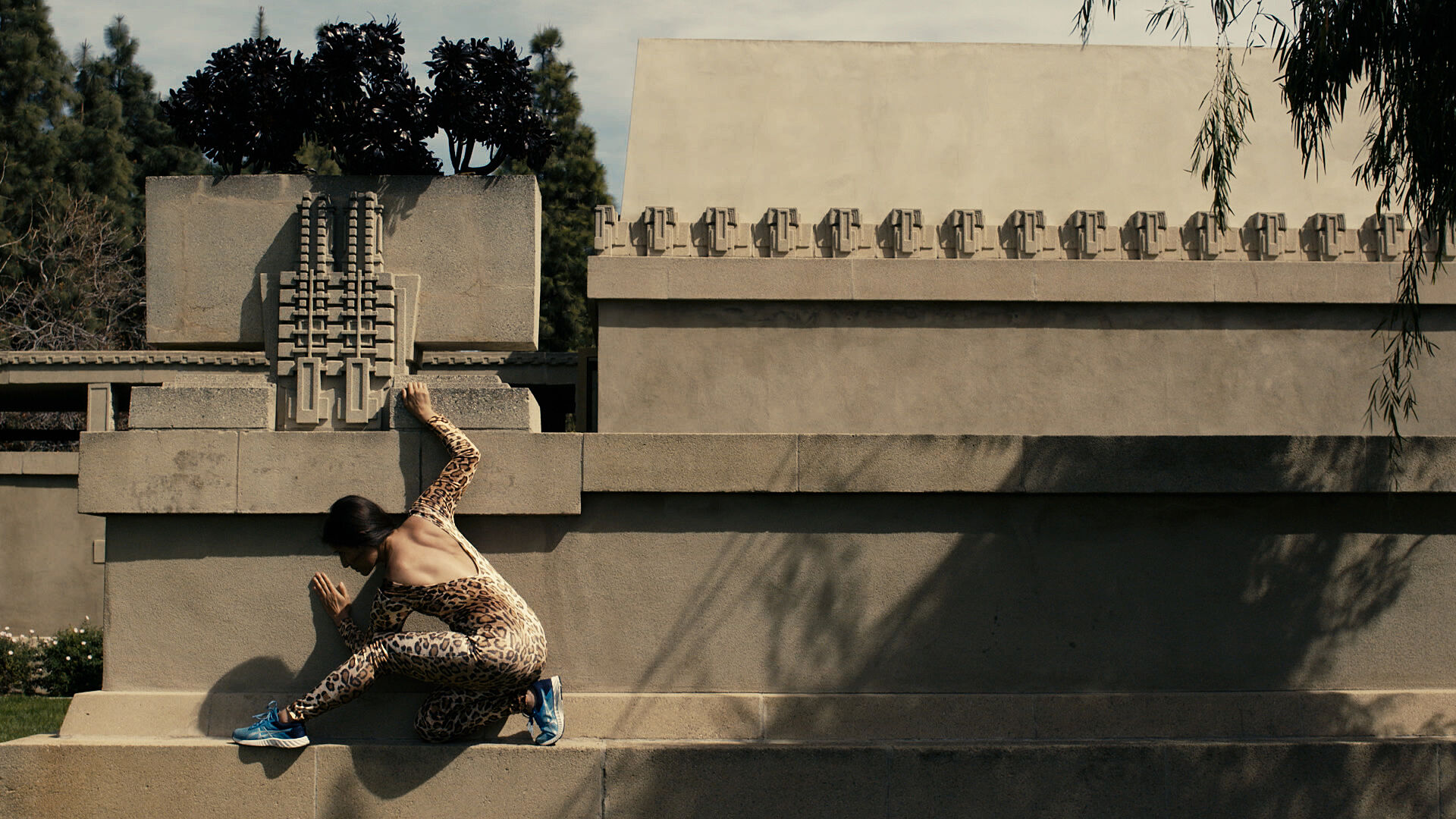Visual description
Clarissa Tossin’s work, titled a cycle of time we don’t understand (reversed, invented, and rearranged) from 2017, is a sculpture of variable dimensions displayed on a white wall. Composed of five distinct sculptural elements made of silicone, walnut, and faux terracotta, the work balances and plays with relationships between positive and negative space. Toward the upper left, a corner of what could be a wall or a screen extends longer horizontally than it does vertically. The border of the wall or screen is made of brown wood. The screen itself is fragmented and fractured. Etched into the material are Mayan symbols and hieroglyphs. Toward the center, two orange hands are affixed to the wall. While both hands have their palms facing the viewer, one hand is turned upward and the other is turned downward. The upside down hand has a tan cord dangling from behind it. Below the hands is a small orange foot with its toes pointing towards the ceiling. In the bottom right corner is a continuation of the upper left; a small right-angled piece of wood framing surrounding a fragmented piece of wall or screen is inscribed with symbols or hieroglyphs. The use of negative space is notable: the work is as much what is presented as what is not. The fractured pieces of wall or screen suggest an interrupted story, an incomplete telling or, perhaps, a purposeful redaction.
The installation explores appropriation, representation, and translation. The work is based on the Mayan Theatre in Los Angeles—a prototypical example of the late 1920s Mayan Revival style that co-opted the architecture and iconography of pre-Columbian Mesoamerican cultures. Originally a venue showcasing a range of theatrical productions, including musicals and comedies, this Mayan-inspired setting has also been used as a Hollywood film set, a porn theater, and now a nightclub since 1990.
Like the architecture of the Mayan Theatre itself, Tossin’s work fractures the idea of the copy. Not forgetting the power dynamics at play, Tossin looks to appropriation as a process of translation and recreation, acknowledging that some elements of comprehension or context are lost.
Not on view
Date
2017
Classification
Sculpture
Medium
Silicone, walnut, faux terracotta (dyed plaster)
Dimensions
Dimensions variable
Accession number
2019.35a-e
Credit line
Purchase, with funds from the Painting and Sculpture Committee
Rights and reproductions
© Clarissa Tossin
Audio
-
Descripción verbal: Clarissa Tossin, A cycle of time we don't understand (reversed, invented, andrearranged), 2017
In Inheritance (Spanish)
0:00
Descripción verbal: Clarissa Tossin, A cycle of time we don't understand (reversed, invented, andrearranged), 2017
0:00
Narrator: La obra de Clarissa Tossin titulada A cycle of time we don’t understand (reversed, invented, and rearranged) de 2017 es una escultura de dimensión variable que se exhibe sobre una pared blanca. Compuesta por cinco elementos esculturales distintos hechos de silicona, nogal y terracota falsa, la obra pone en equilibrio y juega con las relaciones entre el espacio positivo y el espacio negativo. Hacia la parte superior izquierda, se puede apreciar la esquina de lo que sería una pared o pantalla que se extiende en sentido más horizontal que vertical. El marco de la pared o pantalla está hecho de madera marrón. La pantalla en sí está fragmentada y fracturada. Sobre el material, se pueden ver símbolos y jeroglíficos mayas grabados. Hacia el centro, hay dos manos de color naranja fijadas a la pared. Si bien ambas manos muestran las palmas al público, una mano apunta hacia arriba y la otra, hacia abajo. De la mano que apunta hacia abajo, cuelga por detrás un cordón de color tostado. Debajo de las manos, se puede observar un pie pequeño de color naranja con los dedos apuntando hacia el techo. En la esquina inferior derecha, se encuentra una continuación de la esquina superior izquierda: una pieza de madera con un pequeño ángulo recto que enmarca un fragmento de pared o pantalla lleva inscritos símbolos o jeroglíficos. El uso del espacio negativo es notable: la obra se trata tanto de lo que está presente como de lo que está ausente. Las piezas fracturadas de pared o pantalla sugieren que existe una historia interrumpida, una narración incompleta o, quizá, una redacción deliberada.
La instalación explora la apropiación, la representación y la traducción. La obra se basa en el Mayan Theater de Los Ángeles—un ejemplo prototípico del estilo del renacimiento maya a fines de la década de 1920 que se apropió de la arquitectura e iconografía de las culturas mesoamericanas precolombinas. Originalmente un sitio donde se exhibía una variedad de producciones teatrales, incluidos musicales y comedias, este edificio inspirado en la arquitectura maya también se ha utilizado como set de rodaje de Hollywood o como cine de películas pornográficas. A partir de 1990, funciona como club nocturno.
De la misma manera que la arquitectura del Mayan Theater, la obra de Tossin fractura la idea de la copia. Sin dejar de lado las dinámicas de poder en juego, Tossin ve la apropiación como un proceso de traducción y recreación, y reconoce que algunos elementos de comprensión o contexto se pierden en dicho proceso.
-
Verbal Description: Clarissa Tossin, A cycle of time we don't understand (reversed, invented, andrearranged), 2017
In Inheritance
0:00
Verbal Description: Clarissa Tossin, A cycle of time we don't understand (reversed, invented, andrearranged), 2017
0:00
Narrator: Clarissa Tossin’s work, titled a cycle of time we don’t understand (reversed, invented, and rearranged) from 2017, is a sculpture of variable dimensions displayed on a white wall. Composed of five distinct sculptural elements made of silicone, walnut, and faux terracotta, the work balances and plays with relationships between positive and negative space. Toward the upper left, a corner of what could be a wall or a screen extends longer horizontally than it does vertically. The border of the wall or screen is made of brown wood. The screen itself is fragmented and fractured. Etched into the material are Mayan symbols and hieroglyphs. Toward the center, two orange hands are affixed to the wall. While both hands have their palms facing the viewer, one hand is turned upward and the other is turned downward. The upside down hand has a tan cord dangling from behind it. Below the hands is a small orange foot with its toes pointing towards the ceiling. In the bottom right corner is a continuation of the upper left; a small right-angled piece of wood framing surrounding a fragmented piece of wall or screen is inscribed with symbols or hieroglyphs. The use of negative space is notable: the work is as much what is presented as what is not. The fractured pieces of wall or screen suggest an interrupted story, an incomplete telling or, perhaps, a purposeful redaction.
The installation explores appropriation, representation, and translation. The work is based on the Mayan Theatre in Los Angeles—a prototypical example of the late 1920s Mayan Revival style that co-opted the architecture and iconography of pre-Columbian Mesoamerican cultures. Originally a venue showcasing a range of theatrical productions, including musicals and comedies, this Mayan-inspired setting has also been used as a Hollywood film set, a porn theater, and now a nightclub since 1990.
Like the architecture of the Mayan Theatre itself, Tossin’s work fractures the idea of the copy. Not forgetting the power dynamics at play, Tossin looks to appropriation as a process of translation and recreation, acknowledging that some elements of comprehension or context are lost.
-
Clarissa Tossin, A cycle of time we don't understand (reversed, invented, and rearranged), 2017
In Inheritance (Spanish)
0:00
Clarissa Tossin, A cycle of time we don't understand (reversed, invented, and rearranged), 2017
0:00
Narrator: La artista Clarissa Tossin basó esta escultura en el diseño de interiores del Mayan Theatre, en el centro de Los Ángeles.
Clarissa Tossin: Froté capas de silicona en partes de las paredes y puertas, y en otros detalles del interior del Mayan Theatre, y luego la despegué. Las combiné con gestos de la mano y posiciones del pie que tomé de murales y piezas de alfarería de los antiguos mayas en los que se representaba a bailarines, artistas o ceremonias.
El Mayan Theatre es un edificio exquisito en términos de cómo se utilizó sitios arqueológicos y figuras mitológicas específicos en el diseño de interiores. Parte de mi trabajo era encontrar los lugares originales, porque realmente son tres sitios arqueológicos combinados y convertidos en un teatro.
En esta escultura, quería que el edificio danzara, o que al menos mostrara algún tipo de movimiento corporal. Por eso las impresiones del edificio están hechas con silicona. Es un material ligero y con una caída que refleja mucho más la fluidez del cuerpo que la rigidez de las paredes y las estructuras arquitectónicas.
Me interesaba la arquitectura del lugar y cómo se la recreó y reformuló para convertirla en un teatro histórico en una ciudad cuya gran parte de la población es maya. No sé cuántos de ellos saben que existen estos edificios. Mi pregunta era: “¿Qué significa tener estos espacios como sitios de referencia o históricos, y cómo se relacionan con el tejido cultural de esa ciudad hoy en día?”. Fue interesante realizar esta investigación arqueológica del presente.
-
Clarissa Tossin, A cycle of time we don't understand (reversed, invented, and rearranged), 2017
In Inheritance
0:00
Clarissa Tossin, A cycle of time we don't understand (reversed, invented, and rearranged), 2017
0:00
Narrator: Artist Clarissa Tossin based this sculpture on the interior design of the Mayan Theater, in downtown Los Angeles.
Clarissa Tossin: I rubbed layers of silicon on sections of the walls and doors, and some other interior design details of the Mayan Theatre and then peeled it out. I combined them with some hand gestures and feet positions that are based on ancient Mayan pottery and murals where dancers, or performers, or ceremonies are being depicted.
The Mayan Theatre is a building that is really rich, in the way it used specific archaeological sites and mythological figures into its interior design. Part of my work was to find the original sources. Because it's really the combination of three archaeological sites, but made into a theatre.
In this sculpture I wanted to make the building dance, or to make the building embody some physical bodily qualities. That's why the imprints of the building, they made out of silicon. It’s this really soft and drape-y material that speaks more to the body than the rigidity of walls and architectural structure.
It was an interest in architecture and the relationship with Mesoamerican, Mayan templar architecture and how it was recreated, reformulated, and how it became a historical movie theater in a city that today has a big part of the population who is Mayan. And I'm not sure how aware they are of these buildings in the city. And my question was, what does it mean to have these spaces as landmarks and historical buildings, and how they relate to the cultural fabric of that city today? So it was interesting to do this archaeology of the present.



